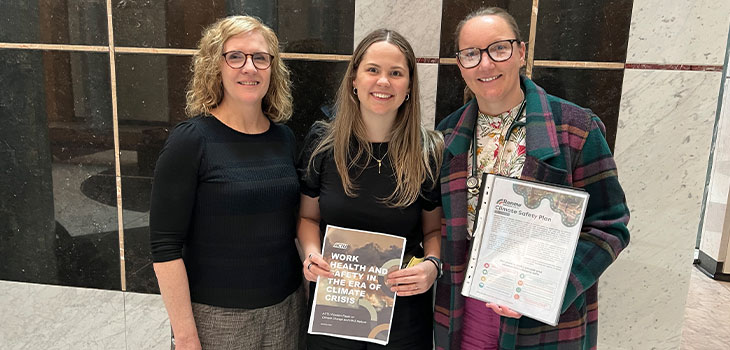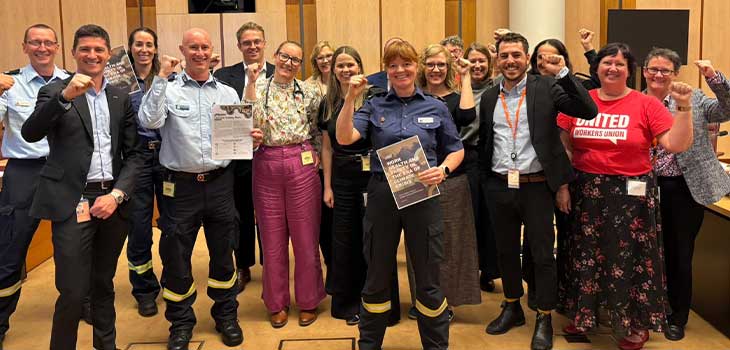Unions are calling for new work health and safety laws to better protect workers from climate change, including extreme heat, natural disasters and air pollution.
A delegation of union leaders and workers, including nurses, firefighters, and teachers, travelled to Canberra today to launch a new report Work Health and Safety in the Era of Climate Crisis laying out the extreme safety risks to workers and reforms needed in the face of rising temperatures.

“Australian workers and communities need to be kept safe from the impacts of climate change that have already become unavoidable,” said Australian Council of Trade Unions (ACTU) President Michele O’Neil.
“The current 2035 emissions target has us on a path toward warming above 2 degrees, an unacceptable outcome that we all need to work harder to prevent. Australia must also lift its ambition to decarbonise to exceed 70% emissions reduction by 2035.
“At the same time, our work health and safety regime needs urgent improvement to protect workers from the climate impacts we’re already witnessing, let alone what we’ll see in the 2030s and 2040s.”
Australia’s current work health and safety regime does not enforce mandatory thresholds for safe temperature or indoor and outdoor air quality, heat stress protocols, co-developed emergency plans, or any other binding climate adaptation measures.
More frequent and extreme climate events
The first National Climate Risk Assessment released in September confirmed that Australia is likely to experience more frequent and extreme climate hazards.
Unions are concerned that most workplaces are already becoming more dangerous, leaving workers exposed to ever increasing climate hazards.
“Safe Work Australia must urgently develop binding regulations to protect workers from extreme heat, natural disasters, insect-borne diseases, and poor indoor and outdoor air quality — all hazards made significantly worse by climate change,” said Ms O’Neil.
“Countries like South Africa, Brazil, Qatar and Japan have strong laws to protect workers from extreme heat and Australia needs a much stricter regime to meet those international benchmarks.”
According to the National Climate Risk Assessment, Australia is on track to experience a 350% increase in extreme heat days if 3 degrees of warming occurs, leaving outdoor workers in agriculture, construction and transport at higher risk of everything from heat exhaustion to cardiac arrest.
Under current forecasts, heat deaths are predicted to spike 444% in Sydney, 423% in Darwin, and 312% in Perth if 3 degrees of warming takes place.
Climate change-driven bushfires and heatwaves increase concentrations of ground level ozone, nitrogen dioxide, and particulate pollution, which can cause cancer, stroke, and respiratory illness in indoor and outdoor workers.
Worsening natural disasters add to the strain on healthcare and emergency service workers, who are required to work longer hours in more hazardous conditions, risking exposure to contaminants from fires and floods.
Warming temperatures are also increasing the spread of disease-carrying insects, exposing farmers, foresters, gardeners, and construction workers to illnesses like Japanese encephalitis, which has spread from far north Queensland to Victoria, New South Wales and South Australia.
Today’s report was released as part of a broader campaign by Renew Australia for All, an alliance of 80 unions, clean industry, climate and community groups calling for more Commonwealth investment in climate resilience measures across healthcare, local government, housing, agriculture and our emergency responses.








